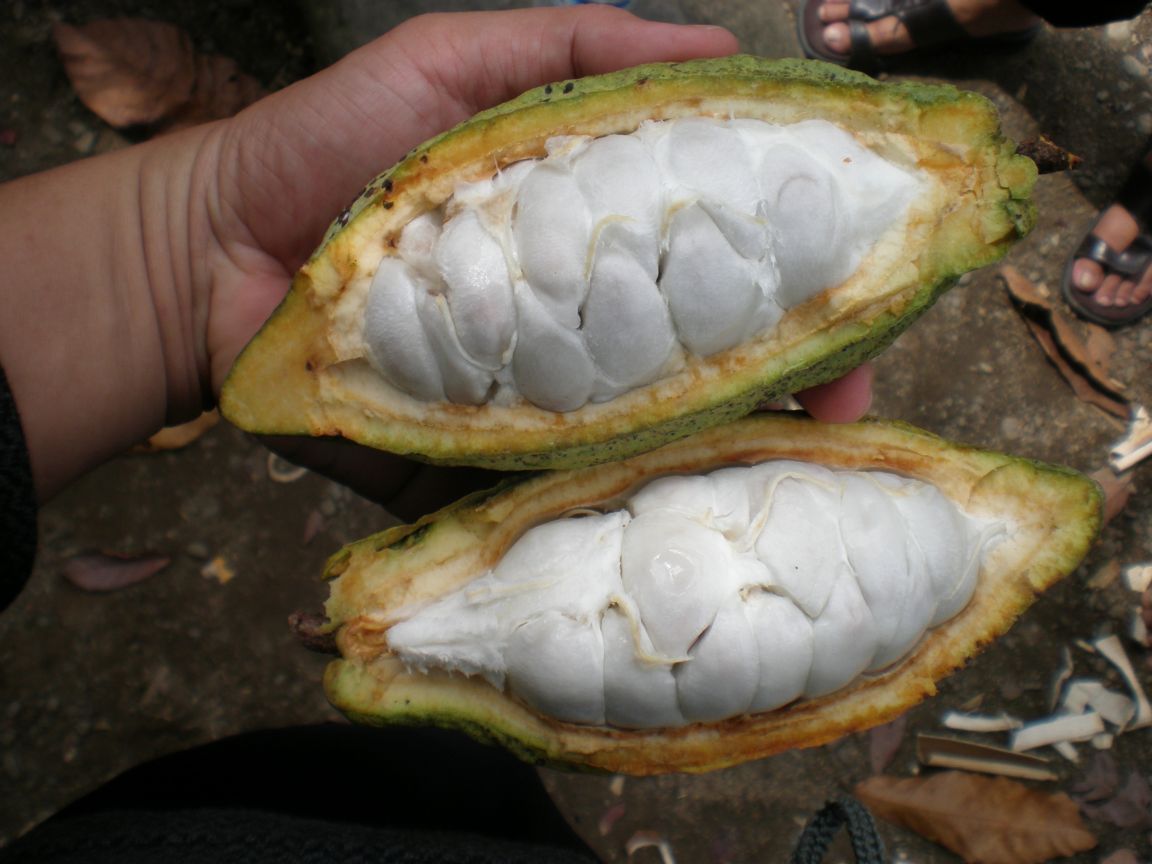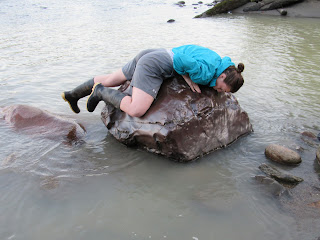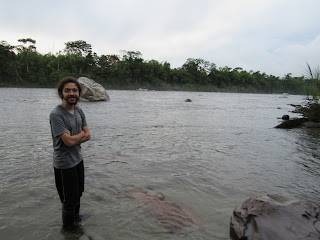I’m not sure if anyone has heard of HelpX but it is
basically a website that is a hub for finding places to volunteer across the
world. Usually, in return for working around 4 hours a week, 5 days a week, you
get a free place to stay and free meals. Finding a place was tricky because we
had to find something on our way back up to Colombia and a place that would
host us for a shorter amount of time – most places want you to work for at
least 2 weeks.
 |
| The river flooded from all the rain we had so the walk back at the end of the week was a little more adventurous |
 |
| A mini garden |
 |
| Ohafa loved the idea that this was a home without walls because walls aren't needed when you live in the middle of no where |
 |
| Kitchen! |
 |
| Here is where we got our drinking water. They found a natural spring in the hill and they used bamboo to set up a drinking spout |
 |
| Stream for washing clothes |
 |
| This spider pic is only here so I can mention that I saw the biggest spider I have ever seen in my life. It was the size of a dinner plate and it was terrifying |
The point of this project was that the family who owned the land had
all moved in to the city (Tena) but were unhappy there. Their house in the city
is mostly unfinished.
 |
| Where we stayed the first night |
 |
| No hot water |
The parents have 10 adult children, most of whom still
live in the house all together. Some even have families of their own, so in
this one house there are about 3 or 4 separate families living there plus
single children. We stayed here our first night and our last night in town. The
first night there we discovered the family had a pet when Ohafa calmly told me,
“Grace, there is a large reptile behind you.” I was happy to learn, it was the
slow-moving family pet turtle, George and not some other large jungle reptile.
On our last night there, we learned that its normal for Ecuadorian parties to
blare music next to your room until 9am the next morning so going to bed at
10PM to catch up on rest isn’t helpful and then “honored guests” aka us get
served fish with the head and eyeball still on and you can’t refuse no matter
how hard you try.
Anyways, they are unhappy and want to move back to the
jungle and live off the land, but the land isn’t ready to be lived off of yet.
So, the project resolves around preparing the land. The project has been on
going for a couple of years now and that is why the structure is so beautiful.
Now, they are working on building a few more living structures and on growing
the farm, so it can be self-sustainable. Lucas heads the project – he is a guy
from France who has known the family for 10 years. He has been living in the
area and working on the project for the past year and a half. The family has
taught him almost all they know about the local plants, animals and culture.
For our 6 days spent in the jungle it was just me, Ohafa and Lucas.
When we first arrived, it was raining. We used some kindling
and firewood under the benches in the shelter from the rain to start a fire.
Ohafa asked what happens when it rains for like 3 days in a row, does he run out of firewood? Lucas responded that in all his time here, it has never rained 3 days in a row. It proceeded to rain for a total of 8 days. This was the first of many “firsts” for Lucas during our time as volunteers. Due to all of the rain, and the nature of the project, our week in the jungle turned into more of a cultural exchange than really working.
Ohafa asked what happens when it rains for like 3 days in a row, does he run out of firewood? Lucas responded that in all his time here, it has never rained 3 days in a row. It proceeded to rain for a total of 8 days. This was the first of many “firsts” for Lucas during our time as volunteers. Due to all of the rain, and the nature of the project, our week in the jungle turned into more of a cultural exchange than really working.
We learned a lot about the local plant and animal life.
Like:
This might seem obvious but, banana trees aren’t trees, its
actually the largest flowering herb and once the plant flowers and grows bananas
once, it won’t flower again so you cut it down.
 |
| This is a banana tree that we cut down 30 minutes ago before the picture and it had already grown this much again in the middle, seriously, this place is like magic |
There are 5 different types of bananas grown in the area.
 |
| a few different types |
Apparently 3 papaya seeds a day is good for your immune
system. You have to chew them, you can’t just swallow them.
 |
| Here's a video of Lucas cutting down a papaya that we will eat for breakfast |

The soil here is incredible, things grow so well here. Right
next to where the old kitchen used to be, there is an avocado tree, a passion
fruit tree and an orange tree all growing because of the seeds that were thrown
out while cooking.
We discovered plants that are good for mosquito bites, sun
burns, regular buns, good for digestion, good insect repellent, the list goes
on.
In one hectare of the Amazon, there are more species of
trees than in all of Europe combined
More than 80,000 kinds of plants exist in the Amazon
 |
| Yuca before we harvested it for dinner |
 |
| We cut up the tree to plant in the ground again |
 |
| Cacao tree |
 |
| White cacao |
 |
| Lucas explaining how to prepare white cacao, first, you cut it open |
 |
| The white part is sweet but not the part you eat, you have to get the seed out of the middle |
 |
| These are what the seeds look like, they are full of protein. You fry them, salt them, and then eat them |
These weird chickens without neck feathers are native to
this region
We learned even more about spiritual life:
First, all plants have energy and spirits. Some good and
some bad. Lucas accused of being the reason it rained every day. Lucas kept
saying how unusual it was for it to rain every day and we said, for us, it was
normal because it was all we knew. Lucas told us we need to be careful when we
say stuff like that because spirits are listening, and our energies are
affecting the weather. I then said, “to all the spirits, I would like sun
please!” That’s when we learned addressing all spirits is dangerous.
Also, its not good to laugh too loud when in the jungle because there are so many spirits everywhere and one of them might thing that you are laughing at them.
When Shamans are creating remedies with the plants, the plants talk to the Shaman and tell them what plant to use and how much of it.
Rainy times and super sunny times are when bad spirits are
strongest, so its best not to work during those times otherwise you’re more
likely to get sick. Since it was rainy pretty much always, we didn’t have to
work, like, ever. Here are some shots of some rare moments when we actually
worked.
 |
| Learning how to yield a machete |
 |
| Making jungle crepes. This probably doesn't really count as work, but it was delicious. All in all, the food we ate in the jungle was amazing. Lucas was an amazing chef, plus we were usually eating food that we picked that day. |
For a few days Ohafa was infected with the stinky bad
spirits. Lucas – who lived in Thailand for a year and a half – had learned how
to heal with his hands. He said that every muscle in your back is connected
with a different part of the body, like the stomach, the heart, etc. Through
massage, he can diagnose the problem with the person feeling ill.
Before testing Ohafa, Lucas first put some essential oils on his wrist as protection, then he got to work. He gave Ohafa a massage, telling him he was tight everywhere (a night of vomiting and no sleep will do that to ya), and finally zoned in on Ohafa’s left trap muscle that was giving off the most heat and tightness. This is connected to the large intestine. He told Ohafa to go to bed and lay down for a while.
In the meantime, Lucas sat down and after a few moments commented that Ohafa’s bad spirits were quite strong and that he didn’t protect himself enough. That meant that he was started to feel bad himself. So, Lucas cut off a piece of a termite home and started burning it to clear out the bad spirits in the house. He specifically lingered under where Ohafa was sleeping above.
 |
| Termite house |
 |
| Termites fleeing the burned wood |
 |
| Chao stinky spirits |
For my 19th birthday, my friend Josie got me a framed
preserved butterfly. It is a magnificent blue butterfly that I have had the
pleasure to see on both my backpacking trips through South America. This time,
when we saw it, Lucas told us that here, people believe that when you see this
butterfly, you will have an unexpected visitor or something good will happen. I
wrote down this tidbit, not really thinking much of it. 3 hours later, a woman
and 4 children show up at our remote home. They are relatives of the family
who’s land it is. The butterfly did its job. It was during one of the rare
moments of sun so we all went on a walk together and ended up at the waterfall
on the property.
 |
 |
| When you mash the seeds up inside this weird plant, it turns into a red paint. It is tradition to paint faces with it |
We learned that stones are jails for bad spirits. Shaman’s
trap them there to keep the village safe. I found this out after admiring this
rock for days. Hopefully, there are no bad spirits jailed there yet.
 |
| If you don't see why this rock is cool, there is no point trying to explain it. |
 |
| I tried so hard to chip off a piece of it to take some with me to no avail. The rock is just so perfect |
And we learned about local culture:
Local children either go to school in the morning or in the
afternoon. There are not enough resources to have day long school. The schools
aren’t very good to begin with and it is hard to find qualified teachers, so
even for the little time that students are in school, their education isn’t
strong.
We learned how to make Artisan crafts:
We made bracelets made of string and seeds. The first step
to creating the bracelets is always tying one of the strings to yourself. You
are linked to everything, your aura has a little string that connects you to
every plant and animal and being in existence in the entire universe. This
string tied to your body is a physical representation of that connection and
link. Through craft, you are taking nothing but the earth and creating
something with what the earth gives you.
The seeds used are powerful seeds. They are good to develop
and enhance your own personal power. Some have specific uses, like, San Pedro
protects against bad energy. San Pedro seeds need to be used in groups of 3 for
maximum strength of their power. Other seeds are good for your brain, good for
traveling, etc.
We learned from Ohafa that, “it is hard being special” and that
he, “only has one weak point, [his] body, but [his] mind and [his] spirit are
invincible.
 |
| Zen Ohafa and the banana tree |
And we just had fun:
Ohafa and I played countless games of cards, chess, dice,
and pretty much any other game we could think of.
We learned a new card game called Cambio, which we played
every night after dinner and before bed. (I am going to write down the rules so
if I look back years from now, I will be able to play again, but they probably
won’t be written well enough for anyone else to learn how to play just by
reading my blog – sorry)
-It starts out like golf, everyone gets 4 cards face down
and you can look at 2
Special cards
- - J = you can switch cards with someone without
looking at what they are
- - Q = you can switch cards with someone with
looking at what their card is first
-
- 9&10 = you can look at someone else’s card
-
-7&8 = you can look at your own card
-
- Red K = - 2 points
-
- Black K = 15 points
-
- Face cards are worth their # value, not all just
10
- You can discard your card if the same # is on
the top of the discard pile
-
You can discard someone else’s card if you know
their card and it is the same # of the discard pile – then you get to give them
one of your cards
-
If you try and discard a card and you are wrong,
you get an extra card
-
You play 10 rounds and if they winner after 10
wants to double it to prove themselves, you play 10 more, building off the
scores from the first 10 rounds
We battled an onslaught of ants with our feet and gasoline
who were trying to invade our home and eat us in the process. Ohafa got some up his shorts and it gave a true meaning to dancing like there are ants in your pants.
There was a stray dog that came by every once and a while. One
night, it stole all our snacks Ohafa and I brought with us and we thought that
it had stolen the peanut butter I had brought. (much to our joy, days later we
found it somewhere else)
I had some varying degree of wet hair for the entire time I
was there. We hadn’t showered for 2 weeks.
Our time in the jungle was… memorable to say the least. It
was eight days filled with absurdities that I will never forget.
After leaving the jungle, we started our journey back to
Bogotá for our flight to Brazil. We hadn’t showered for 2 weeks and boarded the
bus to spend the next 2 nights on buses, wait at the border again, for only 3
hours this time, and in total travelled for 40 hours.
During the course of that time, we saw Fast and Furious 8 at
least 2 more times, and we also repeated a few other movies we had already
seen.
And, the greatest tragedy of all, we had an egg catastrophe.
As some of you know, we have pretty much survived on eggs for the past 23 days.
The last day, the very last day, hard boiled eggs were ruined for us for a
while. Before leaving Tena, we decided to peel the eggs and put them in a glass
Tupperware, so they would be easier to eat on the bus. We didn’t finish all of
them and upon our arrival in Bogota, we found the eggs, covered in slime and smelling
worse than possible anything I have ever smelt before.
I don’t know when I’ll have eggs again.











































Great post.
ReplyDeletehttp://www.23hq.com/ayanrajput/a/about
Great post.
ReplyDeletehttps://www.discogs.com/user/BruceHamilla
Great post.
ReplyDeletehttps://www.ted.com/profiles/27048189/about
Great post.
ReplyDeletehttps://www.themehorse.com/support-forum/users/adymathur7/